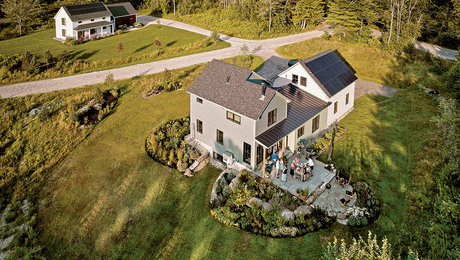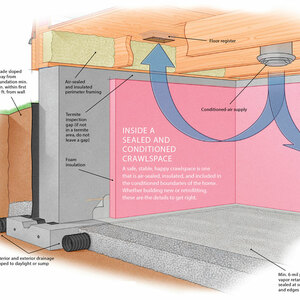FH203, Annual “Houses,” the slate roof

The Vermont house featured on pp. 82-87 was of interest to me, so I whipped up a model of it using my house design software. I was babysitting while my wife went shopping and to do an exercise class at the health club, so I needed a diversion.
There is some total craziness going on, roof-plane-wise, in the way the designer did a porch and connecting breezeway on the end of the house nearest the barn. If you have the magazine, and the time to look, check out the photos, the floor plans, and in particular, the photo on the bottom of pp. 84-85.
See those two fascia tops running at two elevations, the one for the main house, then the lower on for the porch and breezeway?
Why do you think the architect did that? And how do you think he resolved things over on the other side of the house, where the breezeway roof comes to the roof overhanging the front entry.


















Replies
These pics are gonna eat into my pic-post allotment, but what the heck.
They are only meaningful if you have taken a good look at the stuff to which I referred in the OP.
Here you can see, in my workout of the plan, how I made the fascia height common for all roofs. The principal roofs are all 12:12, including the full returns. The shed dormer roofs are at 6.5:12. This view is from the same camera location as the photo on pp. 84-85.
View Image
In this birdseye view, you can see how the roofs resolve together over on the side where the breezeway comes to the corner. The porch roof and breezeway roofs are all at 4.25:12. I cannot imagine resolving the roof joinery with the fascia tops all lower for porch and breezeway, as is shown in just the one photo in the mag spread. Who knows what might be going on over at the other side, up in East Montpelier, VT?
View Image
View Image
"A stripe is just as real as a dadgummed flower."
Gene Davis 1920-1985
That roof would have been "fun" to do!!!
For the life of me I can't understand why the designer put hips, the only hips in the house, on that porch. To me it screams "incongruous".Scott.
I don't agree with you about hips being out of place on that design. The main roof has small hips where the principal planes hip around the corners to do those full width returns under the gables. Without those to divide the elevations, the gabled walls would be unbroken and look too tall. The photo on p. 83 shows that best
There are fine old home around my village with steep-pitched upper roofs, and lower-pitched hipped porches poking out of gabled ends, just like this example. Some are executed better than others, and probably very few had an architect involved in the design and build.
Some have simple shed-roof porches, with their gabled ends badly done, poorly resolved into the main house walls and roofs they intersect.
I took another look at the photo on p. 85 in the magazine, and realized that the builder or architect did an irregular ("b*stard") hip on the one porch end nearest the camera. I believe it was done to be able to run the roof intersect of the principal pitch fully under the upper R window. Study the photo and you'll agree that the hip clearly comes to that posted corner at a plan angle different than a 45.
So I went back and changed the pitch of the end plane from a 4.25:12, to a 6:12, and I think it is closer now to what got built. I'm still scratching my head, though, over that roof edge being lower, and how things resolve on the other (hidden) side.
View Image
View Image
"A stripe is just as real as a dadgummed flower."
Gene Davis 1920-1985
Yeah, I think your second version is more balanced. Are the windows centered in the principal pitch of the porch?Scott.
Sort of. You be the judge.
But I am not sure whether my scheme matches the dims of the prototype. I just threw this model together quickly, trying to get the overall sizings to the same proportions as the one in the mag article. The openings were all just mouseclicked in by eyeball.
In the mag plan images you can see it, and in my model as well, that there is no axis of symmetry that runs through the house and matches its principal roof ridge. In this pic you can see that the gable windows ought to be tweaked a tiny bit to be symmetrical on the gable. You can also see, when looking at the porch roof below, that making that one hip plane to the R steeper, was the thing to do to get a little balance into the design.
View Image
View Image
"A stripe is just as real as a dadgummed flower."
Gene Davis 1920-1985
>>>The openings were all just mouseclicked in by eyeball.Yeah, I know what you mean. Causes me to reminisce for the old days when I got some CAD skills designing our house. I used to love keying in the delta-X and Y values and watching stuff grow. Most gratifying.Nice work. I'll have to pick up a copy of the mag.Scott.